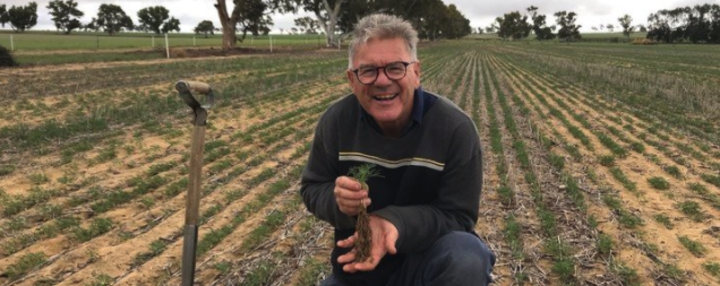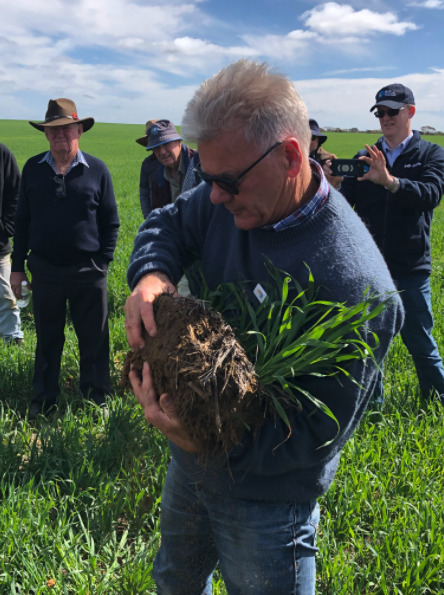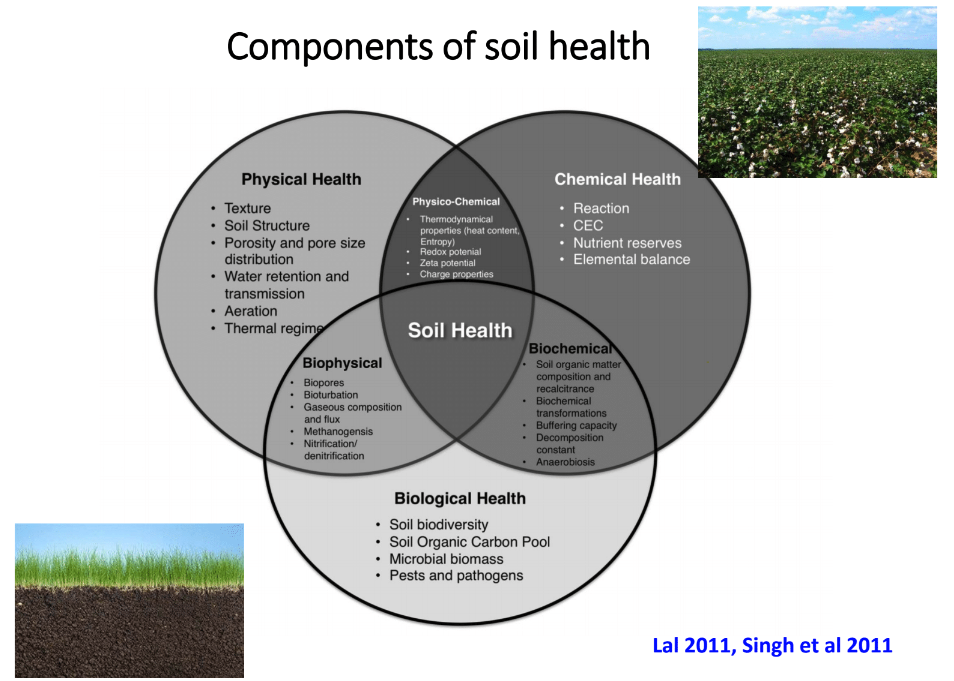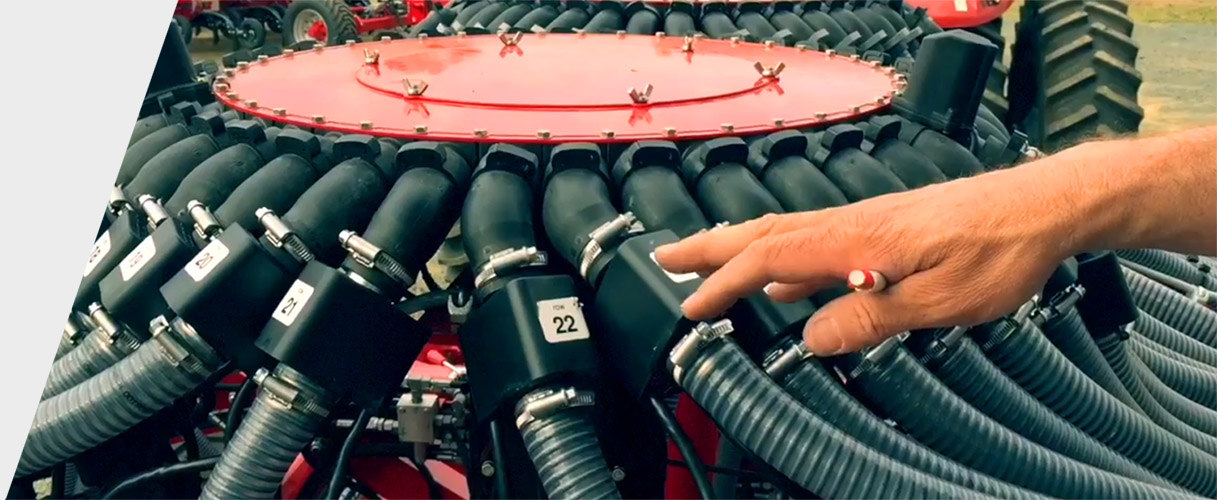
Stuart examines a biologically active root zone in a Lupin crop
Stuart McAlpine labels himself a ‘farmer of bugs’ and believes the regenerative journey is one of constant observation and learning.
- The benefits of biostimulants and how to apply them
- Profit vs yield as farm performance indicators
- Understanding and effectively utilising natural systems
| Farmer | Stuart McAlpine |
|---|---|
| Location | Buntine, Northern Wheatbelt, Western Australia |
| Farming Program | Mixed broadacre, cropping and cattle breeding and trading |
| Farm Size (acres) | 12,500 |
| Climate Zone | Ag Zone 4 : hot dry summer, cool winter |
| Soil Type | Soils are variable, including deep yellow sands, gravels, clay loams and heavier clay soils |
| Rainfall (per anum) | 330mm / 13 inches |
| Years on Regen Journey | 25 |
| Interviewer | Christie Stewart (Wide Open Agriculture) |
Christie:
So Stuart, let’s get started, shall we? What practices have you implemented on your farm that you would consider to be regenerative?
Stuart:
Well, I suppose my first foray into regen ag was with no-till crop establishment. This was in the early 90’s so we were certainly in the first or maybe the second wave of early adopters. We started with a Great Plains disc seeder but because there were maintenance issues involved in disc machines we returned to knife points. We’ve now moved back onto discs in the last few years using Horsch equipment after vast improvement in bearing technology and more robust design around wearing parts. I also started using perennial pastures, starting with some lucerne in the nineties. It probably didn’t work out as well as it could have because of the varieties we used and some dry seasons in there meant variable results. In 2006 I started applying biostimulants, and since then I’ve really ramped up that regenerative journey each year after seeing the benefits of promoting soil biology.
Okay, great. Could you tell us more specifically about the biostimulants that you use?
Yeah, so working with biostimulants was an interesting opportunity that was presented to me because I was chair of the Liebe Group R&D committee. I was the inaugural president for the first five years, and then chaired the R&D committee for the following five. We were responsible for a lot of trial work, so I had a Canadian guy from Best Environmental Technologies come to us with a biostimulant called TM Agriculture wanting to do some trial work on our long term trial site on my farm. I thought it may have been a bit of a “snake oil” product and didn’t really think I’d be talking with him for very long, but the more I talked to him, the more I realised that he was speaking some truths.
So from there, I decided to trial some of their products, (which was helped by them being prepared to fund it). Then, because we’d had a really dry season in 2006 and 2007, and because of my experience with trials, I was offered the opportunity to work across the state evaluating the biostimulant Best TM Agriculture. I decided to take it to generate some off-farm income. We’d had a couple of dry seasons in ‘06 and ‘07 and I wanted to hold onto my employees rather than let them go, which a lot of people were doing at that time.
That experience provided a tremendous opportunity to actually see this product working across a whole range of soil types and ag zones across the whole state that eventually would take me right across Australia.
To be quite frank, I was absolutely blown away with some of the results that I saw over that two to three year period and still continue to be amazed at times with results achieved from activating soil biology.

That’s really interesting. So what kind of rates would you use with the TM biostimulant and how would you apply it?
It was applied at the rate of 250ml/ha with a recommendation of 2 applications for the growing period. So ideally you would apply it to a pre-application with a knockdown, we found that to get the best results in Australia, and then follow it up with another early post-emergent application to give it another stimulant after we’d finished seeding and applying herbicides, (which tend to knock the biology around a bit). Sometimes we would split those applications and apply some on the seed as well to achieve a total rate of 500ml/ha. It also depends a little bit on the season and the soil type as to how we’d apply it as it works best with soil moisture.
We found it was much easier to observe benefits on poorer, sandy soils, and a lot harder on heavy soils because they’re quite fertile anyway and the plants don’t need as much biological activity to get the nutrients that they require.
Some of the benefits of the biostimulant include softening the soil, increased water infiltration, higher soil temperature in cold weather due to increased biological activity, improved grain quality, fewer insect infestations and decrease in the impact of soil diseases such as Rhizoctonia and plant pathogens.
My first trial, I had side-by-side plots measuring how the biostimulant helped with Rhizoctonia, the result showed a straight edge difference, with the treated side showing a 45% increase in yield. The disease was still there, but it just helped the crop to develop greater resilience and increased biomass.
Fantastic. So in terms of regen ag, how have these practices influenced your profitability?
I wasn’t needing to treat as many problems due to better plant and soil health with increased biological activity. The money you can save by spending less on inputs can translate into a huge impact on profitability.
I realized quite early on that I was getting some amazing results when dropping my fertilizer rates as far as gross margin goes, it wasn’t always as high yielding, but my profit margin was higher.
I think farmers tend to have this real sense of ‘FOMO’, you know, that fear of missing out. We tend to stick to what we do because we think that if we don’t do it, we’re going to miss out on the yield results our neighbours might see if they are applying those inputs.
So, in any trials or demonstrations, I would always include some control trial strips treated with the TM biostimulant, but with zero additional fertiliser application. What that did was basically set a parameter on how far I could fall, and what I discovered was that more often than not, when I did some high level replicated trials, these controls were often the most profitable due to my expenditure being considerably less.
Now we’ve had some staggeringly dry seasons since 2000, and if you could achieve the same profits by spending less money, which is effectively what I’ve found, then I’m not having to risk the capital on high inputs but still making acceptable or comparable profits.
So when I’ve compared my data in benchmark groups that I’ve been involved in, my profit margins have been similar, but my yields, not so much. I mean, it’s hard to say because when comparing my yields to trial data from the area, they always seemed to compare quite favourably, then when it comes to ‘pub talk’ there’s always some pretty high yields around.
So yeah, yield is one thing, profit is another and my aim is to utilise the natural system as much as possible whilst spending as little money as possible to return a good profit margin based on that risk.
How long did it take for you to see that profitability or any other benefits? Was it immediate or did it take a number of years?
I was probably fortunate that the trials I implemented on my farm showed an immediate increase in yield and profit. That’s not always the case, often a lot of the benefits from biology come from increased efficiencies, which you only see if you’re prepared to find them. So for farmers that haven’t been prepared to do the trial work or look at dropping their inputs seriously over a period of time and observe how that happens, they may not be headed for the immediate result that they’re hoping for.
I think that we’re starting to concentrate more on profit now, but if you go back 10-13 years ago, there was certainly a real focus on yield. As an industry, we just focused all our trial work around yield and I think it has really held us back. It’s only now that we’re really starting to focus on things like return on investment and understanding those more in-depth financials a lot better.
What was an estimate of the material cost to your business to switch around from your previous system?
That’s a good question. If you’re taking a long term view of the health of your farm and in turn your business, I don’t really believe it cost me anything.
If you focus on yield, then inevitably, you’re going to be trying to divert all of your photosynthetic potential into production. I’ve been very prepared to invest in natural capital. So investing in diverting some of that photosynthetic potential into building the health of my soil; increasing stocks of carbon, my water holding capacity, the water quality on my farm and the quality of my produce.
I believe that these are indicators that allow me to be more sustainable into the future. I mitigate some of my risk by building up the resilience of my soils and not being totally reliant on making big money and then having to spend a lot of that money to repair a lot of the damage that I’ve done in producing that grain, fibre or meat in the first place.
So that was probably a very important moment in my life to actually grab that concept. And unfortunately, I think that there’s probably a lot of people out there who don’t understand this concept, which is why they haven’t followed this regen pathway.

Are there any other key benefits you’ve realized in your production system?
I don’t think there’s any doubt that the meat and grain that I produce is of better quality. We don’t have the numbers to actually hang our hat on that one yet, but I think that it is going to come. I say that based on the positive feedback I get on the quality of grain that we deliver. Also, looking at the health of our animals and how they graze, they tend to do really well on feed that in the past I would have considered as having no value at all. So the stubbles seem to have quite good value, they seem to fatten on stubbles even after rain sometimes.
I believe this is potentially due to my soil, (and everything that grows in it), holding onto a lot more of that nutrition when plants build more slowly and with the assistance of microbiology.
At the end of the day, I’m really farming bugs, fungi, bacteria, and all the other little critters that are in the soil.
They all mine from the mineral matrix in my soil to turn those minerals into new soil. To me, the greatest benefit is just watching that all happen, the increasing depth of the A horizon, the improvement in soil structure, even the smell of the soil! These are the things that probably please me more than anything.
Great. So what influenced you to make these changes in the first place?
Profitability actually. So as mentioned before, I was a co-founder of the Liebe Group, which was started in 1997. At that time, most of the agronomy came out of the state government-funded agriculture department. Our area here was pretty isolated at that point in time, which left us a little bit in the middle of a few offices and we weren’t particularly well serviced.
So we decided to start a group that would increase some focus at a local level. It was absolutely phenomenal! We attracted so many research partners from the industry and were getting some cutting edge research happening right here. It was very successful and we were getting some fantastic yield results. But by about the early 2000’s, I noticed that when I looked at my bank balances, we weren’t actually making any more profit. We were taking more risk, we were spending more money, and it was really hit home by the droughts of ‘02 ‘06 and ‘07 and unfortunately, we’ve had a few more since.
We were generating some quite significant losses because we were spending a lot of money justified on trial results, but the problem with trial results is that you’ve actually got to make a profit to get that benefit otherwise you are just spending more money.
It was then that I really started questioning the whole system and started to focus on soil biology more. As a group, we were always very interested in soil biology being the third component of soil health, and we actually had a long term research site on my farm dedicated to it. But it was in the 2000’s with those droughts that I really started to begin to understand soil biology and it wasn’t until I was introduced to TM Agriculture and the concept of biostimulants that this whole new world opened up to me.

That’s fantastic. So what was the very first step you took to get started?
In hindsight, it was making that conscious decision to use a biostimulant and to see the effect it had on quality, disease, and fortunately, yield, on my farm. As I mentioned before, having the opportunity to watch that product work across the whole state, I just couldn’t comprehend it. I was constantly saying to myself “wow, this is amazing, surely I’m not the first person in the world to come across this?”. So I started doing my homework, and even back then you could find a fair bit of stuff on the world wide web. So it was then that I started delving into finding some research that backed up my observations and it just opened up a whole new world of science that was in its infancy at that stage.
I’m still learning and understanding you know, regenerative agriculture is a continual journey of observation.
I’ve always been a big observer, I love to get the shovel out and have a look at what’s going on down there. There have always been things where I don’t understand what’s going on, but that’s a good thing, nature is incredibly complex! Each year, I’m seeing more science coming through that actually provides an explanation for some of the observations that I’ve been making on this journey over the years.
Fantastic! What would you do differently if you had your time again?
I think the most disappointing part of the journey has probably been the lack of support for soil biology from our peak industry bodies and a lack of support from consultants and agronomists that work with farmers. It still saddens me that some of the fantastic results that I’ve seen with TM Agriculture, in particular, were brushed off by the farmers support network as chance and “just snake oil”. I once had a farmer see a 1t/ha increase in Canola and still never use it again for those reasons, peer pressure can be savage.
It’s definitely improving, but it still goes on today, that disregard of supporting people that are doing things differently. I’ve spent a lot of my own money over the years reading research papers, doing my own replicated research, even down to things such as looking at the DNA profile of soil biota using different biostimulants on my roots. I collected some pretty funky data!
I think that’s the sort of innovative research that needs to be going on. Topics like quorum sensing, rhizophagy, the intersection of pH and redox potential on plant resilience and health, nutrient density and the novel compounds in food production are just some of the topics that I am interested in at the moment.
When I look at some of that cutting edge research that’s happening around the world, I’m a bit disappointed that Australia isn’t at the forefront of it. If I had my time again, I would try to address that. I felt as though I was working in a very lonely space from around 2006 to 2016, which is when the whole regen ag movement started getting a bit more license to exist.
Maybe instead of withdrawing due to peer pressure, I should have been stronger. I think we need to look at our whole system, starting with the fact that the vested ag industry has been protecting the profits it makes off of a high inputs system that has clearly had consequences to our natural capital. So that’s what I would have done differently if I could because I think we’ve missed a good 10 or 15 years of valuable research. Especially in a time where the impact of climate change is really hitting us hard on our profitability.
We could have been much more knowledgeable in natural systems that would have enabled us to build greater resilience in dealing with what’s becoming a very erratic climate. I hope I can play my role in making up for this lost time sharing my story with others.
This journey doesn’t end, of course, there is no perfect recipe as we are always in a state of flux along a spectrum of decisions that we need to make. All decisions have consequences, that’s what tests us, tests life on earth, feeds resilience and ensures that life continues in one form or another.
We as humans need to decide whether we want to be part of that life and contribute in a positive way. Better than the alternative I reckon.
Alright, well that’s about all we have time for Stuart. Thanks so much for talking with us!
No worries at all, thanks.

Christie Stewart is the Farmland Regeneration Coordinator at Wide Open Agriculture.
She is passionate about regenerating agricultural landscapes and the unique biodiverse ecosystems of Western Australia’s Wheatbelt,
Christie enjoys her role working to support farmers on their regenerative journey.


